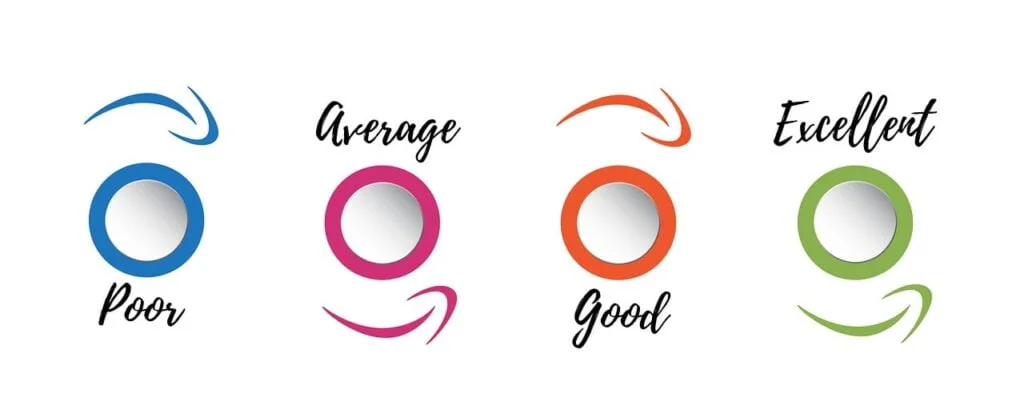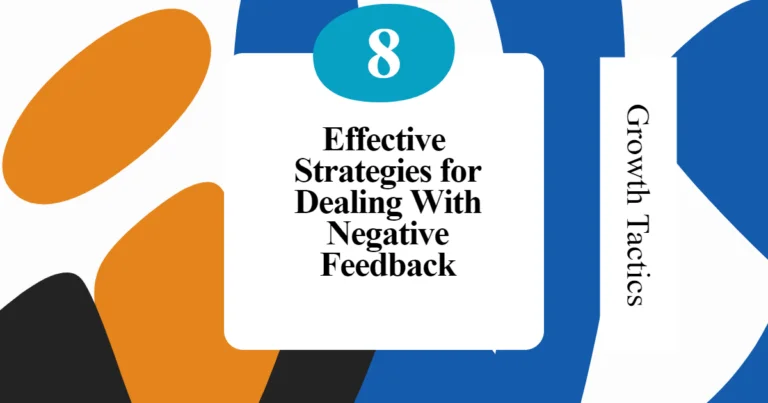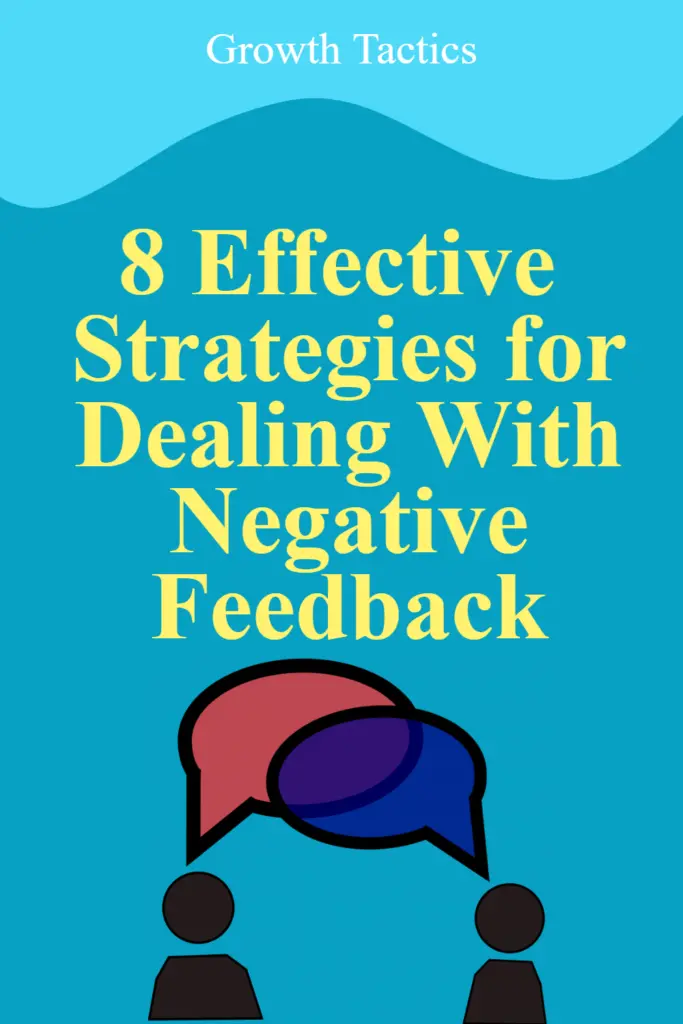Receiving negative feedback can be difficult. It’s human nature to want to be liked and validated. But the reality is that negative feedback is inevitable in our personal and professional lives. In fact, research shows that we receive negative feedback 3-18 times more often than positive feedback.
While our first instinct may be to get defensive or discouraged, negative feedback is a valuable gift. If embraced with a growth mindset, it provides key insights that help us learn, develop, and excel. The key is learning how to accept negative feedback constructively.
With the right strategies, negative feedback can be turned into fuel for self-improvement. This guide will provide 8 effective approaches to dealing with negative feedback and using it to enhance your skills, relationships, and career. Adopting these strategies will help position you as an effective communicator, continual learner, and top performer.
Jump To Section
Why Negative Feedback is Valuable
While positive feedback is certainly appreciated, negative feedback plays a crucial role in professional growth and improvement. Receiving negative feedback allows us to identify areas for improvement that may not be obvious. It forces you to step outside your normal perspective and see your skills and performance through someone else’s lens.
Negative feedback, when delivered constructively, helps build skills by pinpointing specific gaps that should be addressed. This allows you to create targeted action plans to hone those skills. A growth mindset recognizes feedback is a key performance driver, not a personal attack. With this perspective, negative feedback becomes a valuable tool to boost effectiveness rather than something to avoid. Constructive criticism provides clear direction on how you can get better.
Don’t Take It Personally

Receiving negative feedback can sometimes feel like a personal attack, but it’s important to remember that feedback is about your work, not you as a person. Having an open, growth-oriented mindset is key. View feedback as an opportunity to improve, not a judgment on your value or abilities.
When you receive criticism, avoid getting defensive. Instead, make a conscious effort to take a step back. This will help you avoid taking the feedback personally or making assumptions about the intent. Remember that the person providing feedback wants to be constructive, even if their delivery may need some work. Focus on the content of what they’re saying, not the tone or style of delivery.
Keep in mind that everyone receives negative feedback at times. It’s inevitable in both personal and professional settings. How you handle and apply the feedback says more about you than the feedback itself. Maintain perspective – this is one piece of feedback, not a reflection of your entire being or worth. Stay confident in yourself while also being open to growth opportunities.
Actively Listen
When receiving negative feedback, it’s important to actively listen to what the person is saying. Give your full, undivided attention, and refrain from interrupting or getting defensive. If needed, take notes to refer back to what was said later.
Ask clarifying questions if you need more details or examples to understand the feedback. For instance, you could say, “Could you provide a specific example of when I didn’t meet expectations on that project? I want to make sure I fully understand.”
Actively listening shows the person giving feedback that you are engaged and want to understand their perspective. It also helps ensure you comprehend the core issues instead of making assumptions. Stay focused on listening rather than preparing your response. You’ll have time after the feedback session to reflect on what was said and plan the next steps.
Ask Follow-Up Questions

Seeking additional context and examples when you receive negative feedback is crucial to fully understanding the issues raised. Don’t hesitate to ask follow-up questions to the person providing feedback. Ensure you fully comprehend their perspective and have all the details you need.
Some good follow-up questions after receiving negative feedback include:
- Can you provide any specific examples of when this issue occurred?
- What could I have done differently in that situation?
- How often does this problem happen? Daily, weekly, occasionally?
- How does this impact my work and the rest of the team?
- On a scale of 1-10, how serious is this issue?
- What steps do you think I should take to improve in this area?
- Is there anything else I should know about this issue?
Asking thoughtful follow-up questions demonstrates you are open-minded, want to understand the criticism, and are committed to improvement. It also allows you to gain actionable insights you can incorporate into your plan for being a better you. Seek to keep the conversation constructive and solution-focused.
Summarize and Confirm
When receiving negative feedback, it’s important to summarize and confirm you understand correctly. Take a moment to return the key points to the person providing feedback. This shows you have been actively listening and allows the other person to clarify if you didn’t quite grasp their intended message.
Say something like, “So if I understand correctly, the key points you’re making are X, Y, and Z. Is that an accurate summary?” Giving a short recap helps demonstrate you are receiving what they are saying. It also allows the other person to elaborate on points you misunderstood or missed.
Recaping shows that you are focused on comprehending the feedback, rather than just waiting for your turn to talk. It helps build mutual understanding in the conversation. Restating the critical points also helps you process the feedback more deeply. This exercise cements the key takeaways in your mind, so you can reflect on them later and turn the feedback into positive changes.
Thank the Person

When receiving negative feedback, show appreciation to the person providing it. Though it may be difficult to hear criticism, remember that constructive feedback is a gift – it provides growth opportunities.
Please take a moment to thank the person for taking the time to share their thoughts and provide feedback. Let them know you appreciate them caring enough about your development to have a difficult conversation. Viewing feedback as a gift will help you maintain the right mindset to learn from it.
By showing gratitude and not getting defensive, you demonstrate emotional intelligence and reinforce your openness to feedback. This builds trust in your professional relationships and motivates the person to continue providing constructive input to help you improve.
Reflect on the Feedback
After you’ve received negative feedback, it’s important to take some time to fully process it before reacting. Don’t rush to respond immediately. Give yourself space to reflect on what was said and how it made you feel. As difficult as negative feedback can be, try to view it as a valuable opportunity for growth rather than a personal attack.
Once you’ve had time to digest the feedback, identify the actionable areas of improvement. Pinpoint specific examples from the feedback and think about how to use this information to boost your skills. For instance, if you received criticism about poor communication, make a plan to work on being a more effective communicator. A growth mindset means using feedback to get better rather than feeling defeated. Focus on the ways you can learn and develop from the experience.
Create an Action Plan
Once you’ve reflected on the feedback, the next step is to create an action plan to address areas for improvement. This involves setting specific goals and outlining the steps you will take.
First, identify 1-2 priority areas from the feedback that you want to focus on improving. These should be specific skills or behaviors that were highlighted. For example, if you received feedback that you need to improve your communication skills, set a goal to become a more effective communicator.
Next, break your goals down into manageable action steps. If your goal is to improve communication, action steps may include:
- Take an online course on active listening
- Practice summarizing conversations back to people to confirm understanding
- Ask clarifying questions during meetings to strengthen comprehension
- Spend 10 minutes each day reflecting on communication experiences
With each action step, set a specific timeline for completion. For example, commit to finishing the online active listening course within 2 weeks. Having a schedule creates accountability.
Also, identify any potential roadblocks to completing the actions and develop plans to overcome them. For instance, if lack of time is a roadblock, see if you can delegate other responsibilities.
Creating and following an action plan shows you are committed to continuous improvement. It also enables you to demonstrate progress to those who provided the feedback. Approaching negative feedback with a growth mindset allows it to become positive and make you better.
Conclusion
As we’ve discussed, negative feedback can feel difficult to hear but provides an invaluable opportunity for growth and improvement. By avoiding knee-jerk defensiveness, actively listening, asking clarifying questions, and creating an action plan, you can turn critical feedback into fuel for positive change.
Remember that even top performers regularly receive constructive criticism aimed at helping them get better. The most effective leaders view feedback as a gift rather than a threat. Adopting a growth mindset allows you to hear feedback with an open mind and use it to hone your skills.
Rather than dread negative feedback, embrace it as a chance to learn. Accepting criticism with grace and appreciation will serve you well at all stages of your career. The skills you build in constructively receiving feedback will help you create stronger teams, boost morale, and enable continuous improvement. Keep growing!


